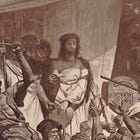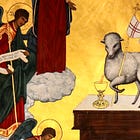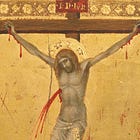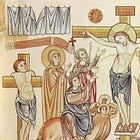Maundy Thursday and the Stripping of the Church
Christ was stripped of everything; so too has the Church been stripped in this period of crisis and apostasy.
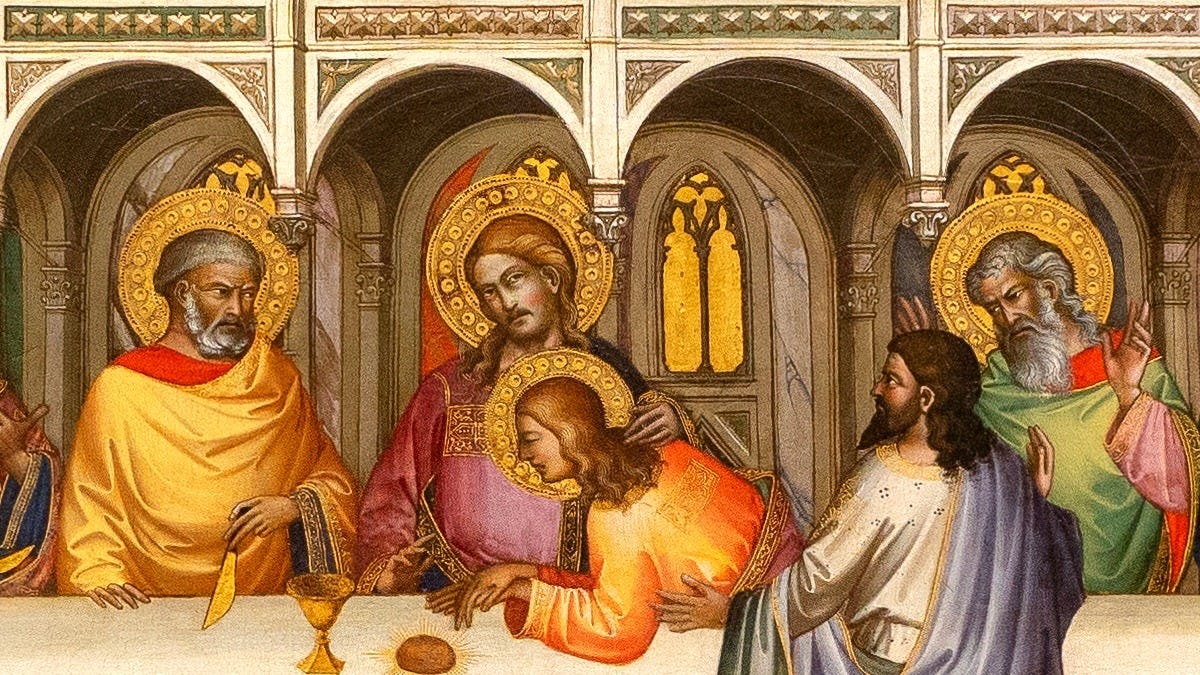
Christ was stripped of everything; so too has the Church been stripped in this period of crisis and apostasy.
The Passion of the Church
The Church is living through a Passion like that of her Head and divine spouse, Our Lord Jesus Christ.
It is a truth of Catholic doctrine that, as Pius XII taught. “Christ our Lord wills the Church to live His own supernatural life.”1 As St Augustine and countless others have taught – including Christ himself, in his revelation to St Paul:
“[Christ] is the Head of the Church, and the Church is His Body, [and the] Whole Christ is both the Head and the Body.”2
While the Church will always be enduring the Passion in some of her members, it does seem to be the case that she is currently re-living the Passion of Christ in a special way.3
This Passion is not affecting just some of her members, but rather the Church as a whole.
The stripping of the altars
We have already seen that the Church appears to be re-living the silence of the Passion. She stands before the world, as Christ stood before Pilate, to be judged – and she stands in silence.
But there were a series of events which led to this moment. Before we arrived at our current Good Friday, we passed through a Palm Sunday, in which Christ was proclaimed as King, and a Maundy Thursday – epitomised by the “stripping of the altars”.
After the Mass of Maundy Thursday and accompanying procession, we witness this ceremony, which Dom Prosper Guéranger explains as follows:
“[The celebrant] goes to the Altar, and takes off the cloths and ornaments. This ceremony signifies the suspension of the Holy Sacrifice.
“The Altar should be left in this denuded state, until the daily offering can be again presented to the Divine Majesty; that is, when the Spouse of the holy Church shall arise from the Grave, the Conqueror of Death.
“He is now in the Hands of his enemies, the Jews, who are about to strip him of his garments, just as we strip the Altar.
“He is to be exposed naked to the insults of the rabble: and for this reason, the Psalm selected to be recited during this mournful ceremony is the 21st, wherein the Messias speaks of the Roman Soldiers’ dividing his garments among them.”4
Could anything better summarise the situation, following the reforms of the Mass and doctrine at the second Vatican Council?
The “daily offering” has not been completely suspended, of course; nor is it possible for the Church to actually die as Christ died. In fact, just as Christ remained God throughout his Passion, we are remarkably blessed with just how much light we can still see from the Church during this eclipse.
But the application is clear: Christ was stripped of everything as he approached the consummation of his sacrifice; and so too has the Church been stripped in this period.
Let’s return to the start of the Maundy Thursday liturgy to try to make sense of all this.
Judas and the Apostles—the stripping away of apostles and friends
Several hours before the Mass, the Roman Church sings the first of three Tenebrae vigil services. With each psalm, one of fifteen candles is extinguished until one remains, alone. At the end, it too is hidden before being once more revealed.
Guéranger gives another explanation whose application is very fitting to our day, mentioning even the idea of an “eclipse”:
“The glory of the Son of God was obscured, and, so to say, eclipsed, by the ignominies he endured during his Passion. […]
“[H]e is, as he says of himself, an object of shame even to his own Disciples, for they are all scandalized in him and abandon him, yea, even Peter protests that he never knew him.
“This desertion on the part of his Apostles and Disciples is expressed by the candles being extinguished, one after the other, not only on the Triangle, but on the Altar itself.”5
Although this ceremony takes place at each Tenebrae of the Holy Triduum, it is even more meaningful on Maundy Thursday, given the various texts of the service referring to the Apostles taking to flight.
The texts also refer to Judas, repeating again and again “It had been well for that man, had he never been born.”
Although it seems that Judas was not present at the institution of the Eucharist, he is present throughout our Mass of Maundy Thursday. It is symbolic that the betrayer is mentioned towards the start of this Mass, just as he was there, marring Christ’s Last Supper by his presence. The Mass opens with mention of Judas in the Collect:
Collect: O God, from whom Judas received the punishment of his guilt, and the thief the reward of his confession, grant us the effect of thy clemency; that as our Lord Jesus Christ in his passion gave to each a different recompense according to his merits, so may he deliver us from our old sins and grant us the grace of his resurrection.
Successors of Judas
As the Church began to enter her current “passion” back in the 1960s, many who had formerly been successors to the apostles unveiled themselves as successors to Judas. As with Christ’s Passion, the current passion of the Church would have been impossible without this betrayal.
Even many of those who did not actively betray or deny him seemed to take to flight, just as Our Lord warned that the other Apostles would do.
In addition, this commemoration of the institution of the priesthood should make us consider how many priests have lost a conception of the great dignity of the priesthood, and comport themselves as social workers or even comedians. This is to say nothing of those who have made an even more definitive break, and completely abandoned their priesthood.
In short, many who had been “once illuminated” and “tasted also the heavenly gift and we made partakers of the Holy Ghost”, fell away into heresy, “crucifying again to themselves the Son of God and making him a mockery.” (Heb. 6.4-6). This applies equally to laymen as clergy.
The loss of Judas’ supposed friendship and the cowardice of the Apostles constitute Christ being stripped of human support, just as the psalms and the prophets foretold:
“I looked for one that would grieve together with me, but there was none: and for one that would comfort me, and I found none.” (Ps. 68.21)
“Friend and neighbour thou hast put far from me: and my acquaintance, because of misery.” (Ps. 87.19)
“I have trodden the winepress alone.” (Isa. 63.3)
And yet Christ was not completely alone in his Passion: we know that Our Lady and St John stood at the foot of the cross, along with others of the holy women.
So too is it for us to stand with “the Whole Christ”, as the Church has her friends and apostles stripped away from her in this terrible crisis.
The warnings of the epistle—stripped away in the Novus Ordo
The Collect’s warning – that Christ’s Passion brings a different recompense according to the merits of the recipient – appears also in the epistle.
St Paul, tells us and the Corinthians, of the institution of the Holy Eucharist, and presents this warning:
Epistle: … Therefore, whosoever shall eat this bread, or drink the chalice of the Lord unworthily, shall be guilty of the body and of the blood of the Lord.
But let a man prove himself: and so let him eat of that bread and drink of the chalice.
For he that eateth and drinketh unworthily eateth and drinketh judgment to himself, not discerning the body of the Lord.
Therefore are there many infirm and weak among you: and many sleep.
This warning should put us in mind, again, of Judas. Some (but not all) hold him to have received the Holy Eucharist at that time. St John Chrysostom writes:
“Judas was not converted while partaking of the sacred mysteries: hence on both sides his crime becomes the more heinous, both because imbued with such a purpose he approached the mysteries, and because he became none the better for approaching, neither from fear, nor from the benefit received, nor from the honor conferred on him.”6
Whether Judas did or did not receive the Holy Eucharist and the priesthood, this warning stands firm. The Roman Church hears it twice at the Corpus Christi Mass, and several other times throughout the year—but only in the traditional liturgy.7
It does not appear at all in the Novus Ordo. Like the cloths on the altar, such salutary warnings have been stripped away from the Church.
Because of this, the consequences mentioned by St Paul been realised, metaphorically, in the Novus Ordo milieu. Many are infirm, weak and asleep in relation to the sacrificial nature of the Mass, to the dogma of transubstantiation, and to the Faith itself.
This revolution has even included the stripping away of the rite of Mass itself, and its replacement with something new and different, which fails to deliver the warnings or the authoritative teaching of the truths revealed by God. Professor Bravin comments on this:
“In measure as the Holy Mass is no longer believed in as a sacrifice, there has begun the passion, the sacrifice of the Church. […]
“For indeed the Mass has been delivered up. The indescribable disorder introduced precisely by this new liturgy has destroyed the unity which hitherto has been the distinguishing characteristic, the singular gift and effect of the celebration of Mass: ‘that they all may be one.’”8
It goes without saying that our crisis is not a question of the Mass alone, still less one individual rite of the Church. The stripping away of the traditional Roman rite is emblematic of everything else that has been stripped away, in terms of doctrine, practice, theology and so on.
And yet we cannot understand this despoliation of the Church without understanding that Christ himself willed this despoliation in his Passion – and indeed in his Incarnation itself.
Christ’s stripping away of his own dignity
In the Gospel reading, we are back in the cenacle with Christ and the Apostles – including the lingering presence of Judas, whose betrayal is mentioned twice.
As with the accounts of his Passion already discussed, Christ shows himself to be completely composed and conscious of what is ahead of him:
Gospel: … Jesus knowing that his hour was come, that he should pass out of this world to the Father, having loved his own who were in the world, he loved them unto the end.
[K]nowing that the Father had given Him all things into His hands and that He came from God and goeth to God: He riseth from supper and layeth aside His garments and, having taken a towel, girded Himself.”
In the washing of his Apostles’ feet, Christ demonstrates and explains a new standard of greatness:
Gospel: Know you what I have done to you? You call Me Master and Lord. And you say well; for so I am. If then I being your Lord and Master, have washed your feet, you also ought to wash one another’s feet. For I have given you an example, that as I have done to you, so you do also.
But it seems that he is also teaching us another lesson. Everything here is conscious. Consciousness and deliberation are the hallmarks of this account, and emblematic of Our Lord’s free choice to suffer.
Just as Christ, knowing what he is about, chooses to rise from supper and strip himself of his garments, so too Christ chooses to enter his Passion.
It is as Newman says of Christ’s Agony in the Garden:
“He was always Himself. His mind was its own centre, and was never in the slightest degree thrown off its heavenly and most perfect balance. What He suffered, He suffered because He put Himself under suffering, and that deliberately and calmly. […]
“He said, ‘Now I will begin to suffer,’ and He did begin.”9
And why? Because, as St Ignatius of Loyola teaches, Christ “desires to suffer” what is to come; that he hides his divinity, which “could destroy its enemies and does not do so”; and that he suffers all this deliberately, for each man, and to atone for each one’s sins.10
While this is consummated in the Last Supper, it is seen throughout the Gospels:
“I have a baptism wherewith I am to be baptized. And how am I straitened until it be accomplished?” (Luke 12.49-50)
“I am the good shepherd. The good shepherd giveth his life for his sheep. […] I lay down my life for my sheep. […] Therefore doth the Father love me: because I lay down my life, that I may take it again.
“No man taketh it away from me: but I lay it down of myself. And I have power to lay it down: and I have power to take it up again.” (John 10.11, 15, 17-18)
“Greater love than this no man hath, that a man lay down his life for his friends.” (John 15.13)
All this is manifested and even further in the institution of the Holy Eucharist and the priesthood. “The Fathers say,” according to de Adalma, “that Christ immolated Himself at the Last Supper”.11
The exact way in which the Last Supper and the Cross are the same sacrifice is a complex area of theology, but it seems sufficient for now to observe this: Christ’s action is intended to show that what he later suffers, he suffers freely and deliberately.
The glory of the Passion and the joy of the Last Supper
Christ’s Passion does not only glorify his Father as the perfect sacrifice offered on behalf of our fallen race.
Our Lord makes clear that, while he will be ultimately glorified and vindicated in his Resurrection, his own glory appears in the Passion, too.
Even few understood it at the time, Our Lord taught all this in advance. After Judas departs from the Last Supper, Christ immediately says:
“Now is the Son of man glorified; and God is glorified in him. (John 13.31)
In his prayer before he is arrested, Christ clearly presents the imminent sufferings as his glorification:
“Lifting up his eyes to heaven, he said: ‘The hour is come. Glorify thy Son, that thy Son may glorify thee […]And now glorify thou me, O Father, with thyself, with the glory which I had, before the world was, with thee.” (John 17.1, 5)
And this is the sentiment of the rest of the Maundy Thursday Mass. There is real joy in this Mass, just as there was at the Last Supper itself:
“And he said to them: With desire I have desired to eat this pasch with you, before I suffer.” (Luke 22:15)
With the Church having spent the earlier part of the week in customary violet, and reading the Passion in full, on Maundy Thursday she puts aside mourning and dons again white vestments.
The Introit talks of the cross in terms of Christ’s glory and triumph:
Introit: But it behoves us to glory in the cross of our Lord Jesus Christ: in whom is our salvation, life, and resurrection: by whom we are saved and delivered. (Gal. vi. 14)
After 40 days (broken by the occasional feast), we hear the Gloria sung out again, accompanied by the ringing of bells.
All this is summed up most perfectly in the soaring Gradual, which is also sung in parts across Tenebrae:
Gradual: Christ became obedient for us unto death, even to the death of the cross.
V. For which cause, God also hath exalted him and hath given him a name which is above all names.
This joy and hope continue also in the Offertory:
Offertory: The right hand of the Lord hath wrought strength: the right hand of the Lord hath exalted me. I shall not die, but live: and shall declare the works of the Lord. (Ps. 117.16-7)
This sense is also present throughout the antiphons and hymns sung during the Mandatum, the washing of the feet.
Christ’s passion was not simply a series of humiliations and sufferings: on the contrary, it represented his great triumph and his offering of the perfect sacrifice to his Father. Although his disciples could not see it until he rose from the grave, the Passion was a greater triumph than that of Palm Sunday.
Surprisingly enough, this is the keynote of the Mass of the Pre-Sanctified on Good Friday.
Conclusion
We see here the resolution of a textual tension in the Mass between the suffering and triumph, in that Christ’s suffering is his awaited glorification, and triumph over sin, death and the Devil.
In this light, the stripping away of Christ’s human support, clothes, dignity and life is not just a humiliation. As St Gregory the Great says:
“All we who proceed to the combat have before us the evil spirits. But the spirits possess noting in the world. They are stripped; we also must be stripped in order to fight against them. The one who, clothed in his garments, contends against a naked adversary will be quickly felled, for he gives his enemy opportunity for a ready clutch.”12
Just as this stripping was Christ’s preparation for battle, sacrifice and victory, the same may apply to this stripping of the Church.
In spite of the untold harm done by the Church being stripped of so much of her hierarchy and faithful and of her ability easily to communicate salutary doctrine to the faithful, she is still able to offer the Holy Sacrifice with her head, and still able to communicate Christ’s divine life to those who submit to the teaching, governance and sanctification which he has established in her.
And just as it was hard to see the Passion as Christ being glorified, so too may this crisis one day be revealed glorifying God and the Church, and as the necessary prelude to something more wonderful than we can imagine in this current darkness.
HELP KEEP THE WM REVIEW ONLINE WITH WM+!
As we expand The WM Review we would like to keep providing free articles for everyone.
Our work takes a lot of time and effort to produce. If you have benefitted from it please do consider supporting us financially.
A subscription gets you access to our exclusive WM+ material, and helps ensure that we can keep writing and sharing free material for all.
(We make our WM+ material freely available to clergy, priests and seminarians upon request. Please subscribe and reply to the email if this applies to you.)
Subscribe to WM+ now to make sure you always receive our material. Thank you!
Read Next:
Further Reading:
Dom Prosper Guéranger – The Liturgical Year
Fr Johannes Pinsk – The Cycle of Christ
Dom Columba Marmion – Christ in his Mysteries
Mgr Robert Hugh Benson – Christ in the Church
Fr Frederick Faber – The Precious Blood
Fr Leonard Goffine – The Church’s Year
Follow on Twitter, YouTube and Telegram:
Pius XII, Encyclical Mystici Corporis Christ, 1943, n. 55. Available at: https://www.vatican.va/content/pius-xii/en/encyclicals/documents/hf_p-xii_enc_29061943_mystici-corporis-christi.html
St Augustine, Sermon 87 on the New Testament (Tenth chapter of the Gospel of John), n. 1. Translated by R.G. MacMullen. From Nicene and Post-Nicene Fathers, First Series, Vol. 6. Edited by Philip Schaff, Christian Literature Publishing Co., Buffalo, NY, 1888. Revised and edited for New Advent by Kevin Knight. Available at http://www.newadvent.org/fathers/160387.htm.
Mgr Robert Hugh Benson wrote that the Church lives out the events of Christ’s life simultaneously in her members. At any given time, in her members, “He is born here, lives, suffers, dies, and eternally rises again on the third day.” Mgr Robert Hugh Benson, Christ in the Church, p 10. The Cenacle Press, Stamullen, Ireland, 2022.
Dom Prosper Guéranger, The Liturgical Year, Vol. 6, Passiontide & Holy Week. St Bonaventure Publications, Great Falls, Montana, 2000. Pp 391-2.
Guéranger 302.
In St Thomas Aquinas, Summa Theologica, III, Q81 A2
“If the faithful happen to attend a votive Mass of the Blessed Sacrament — a popular choice among usus antiquior votive Masses — they will encounter these verses yet again. Moreover, 1 Corinthians 11:27-29 is part of the ninth reading of Tenebrae on Maundy Thursday and the third reading of Matins on Corpus Christi.”
, ‘The Omission that Haunts the Church — 1 Corinthians 11:27-29’ New Liturgical Movement, Mon Apr 11 2016. Accessed 26 Mar 2024. Available at: https://www.newliturgicalmovement.org/2016/04/the-omission-that-haunts-church-1.htmlRev. Luigi Bravin, The Church: After the Council – The Passion. English translation by David Crane, Durham. No publisher or date given. Pp 10-11.
John Henry Newman, ‘Discourse 16. Mental Sufferings of our Lord’, Discourses Addressed to Mixed Congregations, Longmans, Green, and Co. London, 1906, pp 323-341; pp 333-4. Available at https://newmanreader.org/works/discourses/discourse16.html
St Ignatius Loyola, Spiritual Exercises, n. 195-7. Included in Christian Warfare, Society of St Pius X, 2009.
Joseph A. de Adalma SJ et al, ‘On Baptism, Confirmation, Eucharist, Penance and Anointing’, in Sacrae Theologiae Summa IVA (third edition), nn 26-7, pp 247-8. Trans. Kenneth Baker SJ, Keep the Faith, 2015.
St Gregoy the Great, Homiy 32 on the Gospels, PL 76:1233:B. Quoted in Louis Bouyer, The Paschal Mystery, George Allen & Unwin, London 1951, p 166




